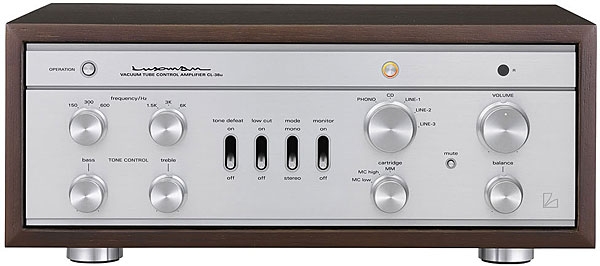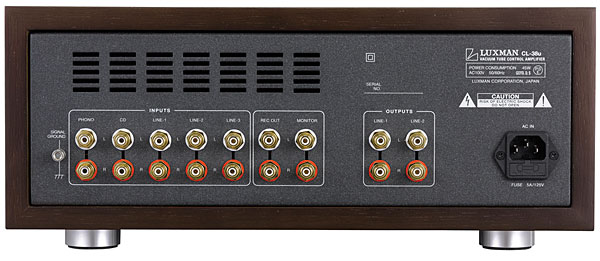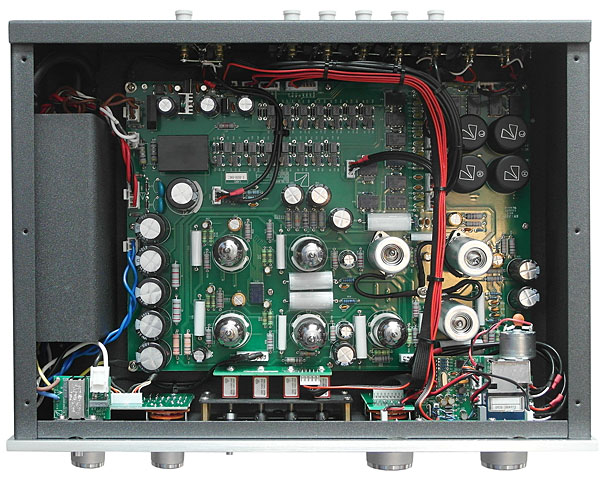| Columns Retired Columns & Blogs |
these reviews and content in general are hitting stereophile.com so quickly now I'm beginning to wonder whether I still need a digital subscription.

That two heritage products share a design aesthetic comes as no surprise, especially considering that their manufacturers began making upscale consumer-audio products at more or less the same time, in the early 1950s. But there the similarity ends: The CL-38u actually is not a heritage product, not a vintage-reissue product, not something cobbled together to capitalize on NOStalgia. And while a critical examination of the Marantz lineage is a chore for which I have no enthusiasm, the fact is: The Luxman Corporation, which this year celebrates its 90th birthday, has never ceased making products that are, in self and in sound, obviously descended from their famous forebears.
I think that's important—not unlike the Luxman Classic CL-38u itself.
Description
Inside the Classic CL-38u's texture-painted steel case, itself covered by a good-looking MDF sleeve with a stained-ash veneer, I found the same mix of old and new technologies that distinguished Luxman's SQ-38u integrated amplifier, which I reviewed for Stereophile's November 2011 issue. For moving-magnet phono gain, the CL-38u uses three ECC83 dual-triode tubes in a shunt-regulated, push-pull (SRPP) configuration chosen to minimize the output impedance of each stage. Five ECC82 dual-triode tubes, also in SRPP configuration, provide line-level gain and the extra amplification required for the Luxman's tone controls: Indeed, the CL-38u offers the ability not only to tailor a system's response with bass and treble boosts or cuts of up to 8dB, but also to tailor such tailoring with switchable hinge frequencies for both filters. The user can select bass boost/rolloff frequencies of 600, 300, or 150Hz, and, in the treble, 1.5, 3, or 6kHz.

Alongside those tubes are three full-wave rectifiers—the largest fitted with its own custom heatsink—plus three solid-state voltage regulators and over a dozen discrete transistors. The last are not in the signal path; rather, they appear to facilitate, in tandem with an equal number of relays, soft switching for the above-mentioned tone controls and the switches for various other functions, including: tone-control defeat, mono, tape monitor, mute, rumble filter (providing 6dB/octave cutoff for frequencies below 30Hz)—and, of course, source selection for four pairs of line inputs and one pair of phono inputs, all single-ended (RCA jacks).
The CL-38u's phono preamp offers more flexibility than its single pair of inputs would seem to imply. A front-panel rotary switch allows the user to select gain and input-impedance settings for MM, high-output moving-coil, and low-output MC cartridges, the latter two with the help of separate pairs of internal step-up transformers. Other Luxman luxuries include two parallel pairs of output jacks, the tape loop, and a remote handset whose functions are limited to volume control and muting.
The build quality of my review sample was very good. Most of the circuitry is found on a single large board; the mains transformer is secreted away in its own shielded case, finished in the same black textured paint as the rest of the case. Each of the three ECC83 tubes gets its own spring-loaded, anti-microphonic can; and the four step-up transformers, made in-house, are encased in shields also done up in black textured paint. (What, was there a sale on the stuff?) Layouts are sensible, wiring is neat, solder joins first-class—and I haven't even mentioned the beautiful veneer work on the CL-38u's wooden enclosure.

Installation and setup
Typical of most audio products from well-established Japanese firms, the Classic CL-38u's packaging is superb: a rugged double carton and a tight-fitting pair of high-quality foam inserts. The preamp itself was covered with a sheet of very nice Japanese paper, and snugged into a drawstring bag made of a distinctive material that seemed a hybrid of fabric and paper.
With its wooden enclosure in place, only the preamp's front and rear panels are left uncovered, although the enclosure's bottom panel has a 6" by 4" opening that corresponds with a similarly sized vent in the CL-38u's metalwork. In use, with the enclosure in place, the Luxman was scarcely warm to the touch. Curiosity led me to try it without its wrap. I had to perch the CL-38u on three Ayre Acoustics Myrtle isolation blocks—the preamp's own feet are attached to the wooden bottom panel—but it neither felt nor sounded any different.
The Classic CL-38u didn't appear to invert signal polarity—at least, not through its MM phono input, which is how I used it most of the time—and it exhibited more or less the same amount of gain as my Shindo Masseto, which is itself generously endowed. The Luxman got along with my turntable and step-up transformer at one end, and my Shindo Corton-Charlemagne mono amps at the other, leading me to suspect nothing in the way of impedance mismatches. I experienced no hum or noise of any sort, and the CL-38u's only performance quirk of note proved to be the surprising degree to which its sound changed during its first 15 or 20 minutes after power-up: Used cold, it was a bit quacky, with so-so presence and poor center fill with stereo recordings; 20 minutes later, the Luxman sounded far more luxe, with terrific presence and texture and musical momentum; after an hour, the sound was better still.
To play LPs, I prefer using my MC pickups with a step-up transformer—especially my Hommage T2—rather than going straight into a phono preamp in which active devices supply the necessary extra gain. But since the Luxman uses internal transformers for its two MC settings, I tried my EMT TSD 15 cartridge straight in and was very pleasantly surprised. With the CL-38u switched to its high-output MC setting—appropriate for the 1.05mV EMT—I heard fine timbral color and texture, better-than-average touch and drive, and unusually good channel separation. The most immediately obvious difference between my usual transformer and that in the Luxman was a lack of bass weight in the latter; then again, one could simply turn up the bass knob, I suppose.

these reviews and content in general are hitting stereophile.com so quickly now I'm beginning to wonder whether I still need a digital subscription.

these reviews and content in general are hitting stereophile.com so quickly now I'm beginning to wonder whether I still need a digital subscription.
This is due to how the calendar crumbles each month.
John Atkinson
Editor, Stereophile

I was in retail in Canterbury in the early eighties just as Luxman stopped making rather lovely things like the L80V http://www.hifiengine.com/images/model/luxman_l-80_front_panel.jpg which were replaced with bland industrial looking gear. Good to see them back. Thanks for the heads up on the timing, frankly Art is worth the price of admission alone.

you've got going on there, Art. I think you'd have to be blind to mistake that Luxman for a Marantz 7.Other than the fact they're both tube preamps with some switches in the middle, I fail to see any cosmetic resemblance whatsoever. the panels are completely different colors, the Marantz cabinet was walnut, the Marantz switches were old fashioned toggles with bakelite knobs,the power switch was an old fashioned slide switch, etc. BTW "C" just meant it came with the cabinet. There was never a Marantz 7A or B., and officially it was always known simply as the Marantz 7.

Yeah but the digital subscription is so cheap I feel comfortable knowing that Art and others at Stereophile are being supported to continue reviewing such great products. Still have my old Luxman L-450 with digital tuner and cassette deck at my parent's place, after all these years they still run great. Love Luxman's gear and have come full circle on their turntable, once thought it ugly now think it is quite attractive.

I noticed JA mentioned in the measurement column the CL-38U's polarity is reversed on MC loads. How pervasive is this on other equipment? If it does occur, then shouldn't that information be in the review copy? It's my understanding that polarity can be corrected by reversing the sources RCA/XLR into the troubled (?) unit. Is that true? I admit to knowing very little about checking and compensating for polarity would love further explanation whether that be in the pages of Stereophile or elsewhere. Thanks!

When RELATIVE POLARITY is miswired the left and right speakers will not agree as to whether the speaker is moving IN or OUT.
One speaker will be playing INWARD notes and the other speaker will be playing OUTWARD notes.
That is because the plus and minus terminals on ONE speaker have the leads REVERSED somewhere in the chain. Unless you bought some really BAD stuff this has occurred by Operator Error and YOU wired one speaker BACKWARDS---YOUR bad.
Positive lead is wired to Minus terminal and Minus lead is wired to Positive terminal. On ONE speaker only.
What John caught is NOT this problem (which would really have messed up the sound terribly and made the bass sound weak as heck)...
John noticed ABSOLUTE POLARITY was miswired.
Which is when ALL the wires are hooked up to the WRONG terminals. On BOTH channels.
So your speakers would play together as they moved IN and OUT. BUT---they would play INTO their cabinets instead of OUT of their cabinets. The speakers would drive the sound INTO the box instead of driving the sound OUT to the air.
It all sounds a bit DEAD when you do that. Exactly as though you were making the sound play INTO the box instead of playing OUT into the room. MUFFLED. Very CLEAR. But MUFFLED.
But not terribly so. It is an effect you really have to pay attention to notice. And have really well set up gear in the first place.
And what is WORSE is that SOME recordings were accidentally encoded with everything reversed. AND BAD RECORDINGS WILL BE PLAYED CORRECTLY WHEN THE POLARITY IS ABSOLUTELY REVERSED.
Just to make all of us crazy. Haha.
But anyway---It is there. It is real.
But probably NOT the first thing you might hate about your new Stereo.
I once accused Benchmark of having their phase reversed on the DAC1. Their engineer called me back and said: "wrong." "It is NOT wired wrong."
Then I triple checked my setup and damn it---MINE was wired backwards.
Oh well. I will never live down the shame...
And life goes on.

Great article, great enough to make me want to buy one. However, the Luxman agent in Australia is not going to stock them, the Luxman agent in the UK is not going to stock them and "On a higher note" won't reply to my webform sales query. It is very annoying.